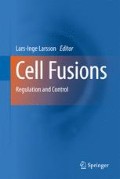Abstract
Cell fusions are important to fertilization, fetal development and homeostasis. Retroviruses infect cells by fusing with them and recent data suggest that mammals may have adopted the retroviral fusion machinery for their own use and combined it with numerous other factors controlling cell specificity and self recognition, motility-migration, filopodia formation, signaling and membrane organization. The multifactorial aspect of the process is suggested to create a certain amount of wobble so that, in specific disease states, heterotypic cell fusions may occur. Professional phagocytes, which specialize in recognizing and eliminating injured or dying cells, appear to be particularly prone to fusion. Such fusions may be useful for repairing damaged tissues and have been harnessed in immune therapy against cancer but may also contribute to disease development and progression.
Access this chapter
Tax calculation will be finalised at checkout
Purchases are for personal use only
Abbreviations
- ADAM:
-
A disintegrin and a metalloprotease
- ASCT:
-
Alanine, serine and cysteine selective transporters
- BMDC:
-
Bone marrow-derived cells
- CD:
-
Cluster of differentiation
- CRISP:
-
Cysteine-rich secretory protein
- DC-STAMP:
-
Dendritic cell-specific transmembrane protein
- env:
-
Envelope
- ERM:
-
Ezrin-radixin-moesin
- F-actin:
-
Filamentous (polymerized) actin
- FuRMAS:
-
Fusion restricted myogenic adhesive structure
- GCM:
-
Glial cells missing
- HERV:
-
Human endogenous retrovirus
- LTR:
-
Long terminal repeat
- MFR:
-
Macrophage fusion receptor
- NSF:
-
N-ethylmaleimide-sensitive factor
- PCD:
-
Programmed cell death
- PKA:
-
Protein kinase A
- RANK:
-
Receptor activator of NFκ B
- RANKL:
-
RANK ligand
- SIRP-α:
-
Signal regulatory protein-alpha
- SNAP:
-
Soluble NSF attachment protein
- SNARE:
-
SNAP receptors
- t-SNARE:
-
Target-SNARE
- v-SNARE:
-
Vesicle-SNARE
References
Andersen TL, Boissy P, Sondergaard TE et al (2007) Osteoclast nuclei of myeloma patients show chromosome translocations specific for the myeloma cell clone: a new type of cancer-host partnership? J Pathol 211:10–17
Bjerregaard B, Holck S, Christensen IJ et al (2006) Syncytin is involved in breast cancer-endothelial cell fusions. Cell Mol Life Sci 63:1906–1911
Blond JL, Lavillette D, Cheynet V et al (2000) An envelope glycoprotein of the human endogenous retrovirus HERV-W is expressed in the human placenta and fuses cells expressing the type D mammalian retrovirus receptor. J Virol 74:3321–3329
Chen EH (2008) Cell fusion. Overviews and methods. Methods Mol Biol 475:1–421
Duelli DM, Hearn S, Myers MP et al (2005) A primate virus generates transformed human cells by fusion. J Cell Biol 171:493–503
Duelli DM, Padilla-Nash HM, Berman D et al (2007) A virus causes cancer by inducing massive chromosomal instability through cell fusion. Curr Biol 17:431–437
Dunlap KA, Palmarini M, Varela M et al (2006) Endogenous retroviruses regulate periimplantation placental growth and differentiation. Proc Natl Acad Sci USA 103:14390–14395
Dupressoir A, Marceau G, Vernochet C et al (2005) Syncytin-A and syncytin-B, two fusogenic placenta-specific murine envelope genes of retroviral origin conserved in Muridae. Proc Natl Acad Sci USA 102:725–730
Dupressoir A, Vernochet C, Bawa O et al (2009) Syncytin-A knockout mice demonstrate the critical role in placentation of a fusogenic, endogenous retrovirus-derived, envelope gene. Proc Natl Acad Sci USA 106:12127–12132
Heidmann O, Vernochet C, Dupressoir A et al (2009) Identification of an endogenous retroviral envelope gene with fusogenic activity and placenta-specific expression in the rabbit: a new “syncytin” in a third order of mammals. Retrovirology 6:107
Kohler G, Milstein C (1975) Continuous cultures of fused cells secreting antibody of predefined specificity. Nature 256:495–497
Mi S, Lee X, Li X, Veldman GM et al (2000) Syncytin is a captive retroviral envelope protein involved in human placental morphogenesis. Nature 403:785–789
Miyado K, Yamada G, Yamada S et al (2000) Requirement of CD9 on the egg plasma membrane for fertilization. Science 287:321–324
Mortensen K, Lichtenberg J, Thomsen PD et al (2004) Spontaneous fusion between cancer cells and endothelial cells. Cell Mol Life Sci 61:2125–2131
Muroi Y, Sakurai T, Hanashi A et al (2009) CD9 regulates transcription factor GCM1 and ERVWE1 expression through the cAMP/protein kinase A signaling pathway. Reproduction 138:945–951
Oren-Suissa M, Podbilewicz B (2007) Cell fusion during development. Trends Cell Biol 17:537–546
Parthasarathy V, Martin F, Higginbottom A et al (2009) Distinct roles for tetraspanins CD9, CD63 and CD81 in the formation of multinucleated giant cells. Immunology 127:237–248
Rothman JE (1994) Mechanisms of intracellular protein transport. Nature 372:55–63
Sala-Valdés M, Ursa A, Charrin S et al (2006) EWI-2 and EWI-F link the tetraspanin web to the actin cytoskeleton through their direct association with ezrin-radixin-moesin proteins. J Biol Chem 281:19665–19675
Simons K, Ikonen E (1997) Functional rafts in cell membranes. Nature 387:569–572
Strick R, Ackermann S, Langbein M et al (2007) Proliferation and cell–cell fusion of endometrial carcinoma are induced by the human endogenous retroviral Syncytin-1 and regulated by TGF-beta. J Mol Med 85:23–38
Weng J, Krementsov DN, Khurana S et al (2009) Formation of syncytia is repressed by tetraspanins in human immunodeficiency virus type 1-producing cells. J Virol 83:7467–7474
Zhou Z (2007) New phosphatidylserine receptors: clearance of apoptotic cells and more. Dev Cell 13:759–760
Acknowledgements
Work by the author presented herein was supported by the Danish MRC, FTP and Lundbeck foundation.
Author information
Authors and Affiliations
Corresponding author
Editor information
Editors and Affiliations
Rights and permissions
Copyright information
© 2011 Springer Science+Business Media B.V.
About this chapter
Cite this chapter
Larsson, LI. (2011). Regulation and Control of Cell–Cell Fusions. In: Larsson, LI. (eds) Cell Fusions. Springer, Dordrecht. https://doi.org/10.1007/978-90-481-9772-9_1
Download citation
DOI: https://doi.org/10.1007/978-90-481-9772-9_1
Published:
Publisher Name: Springer, Dordrecht
Print ISBN: 978-90-481-9771-2
Online ISBN: 978-90-481-9772-9
eBook Packages: Biomedical and Life SciencesBiomedical and Life Sciences (R0)

